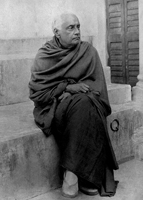Gaganendranath Tagore
BORN DIED EDUCATION QUALIFICATIONS SELECTED POSTHUMOUS EXHIBITIONS SELECTED SOLO EXHIBITIONS HONORS AND AWARD ABOUT THE ARTIST Born on September 18, 1867, into the Tagore family in Calcutta, Gaganendranath Tagore was a self-taught artist and nephew of the great poet and nationalist Rabindranath Tagore. Gaganendranath had very little formal education; he had a very brief period at St Xavier's School, where he briefly became interested in drawing and painting, and an even shorter period in academic studies. His interest in later life and art was limited and conditioned to his love for all things native to Swadeshi. Even his early attempts at sketching are linked to the freedom movement. During 1906-07, he used to receive frequent calls to serve on the special jury. During his visits to the court, Gaganendranath took advantage of his time to make sketches of the jurors and lawyers. Here it is said that he evolved as an artist and caricaturist. In 1907, he founded the Indian Society of Oriental Art along with his brother Abanindranath Tagore, but Gaganendranath remained the driving spirit behind it. Coming from a political background, his family was involved in the freedom struggle, his work seems to be inspired and his imagination is carried away by anything Indian or oriental. His first sketches and landscapes date back to 1905. Although his landscapes bear a Japanese stamp, he was inspired by the Japanese artist Yokoyama Taikan. His work also shows great influence from the experimentalist art that prevailed in Europe at the end of the 19th century. He was extremely proficient in the European technique of watercolor. During 1916-1918, he developed a new language of humor and satire in caricature. His work also found its way into magazines and newspapers and a new art department called Vichitra Club was born. Between 1923 and 1928 he experimented with Cubism and produced a series of paintings filled with mixed geometric shapes. Later he developed his style of cubism, and most of his work in the process advanced towards geometric compositions. Therefore, his work can be roughly divided into specific phases. Japanese-style brush strokes, some with gold backgrounds, portrait sketches, illustrations for Jeevan Smriti, watercolor sketches of rural Bengal, Himalayan studies, the Chaitanya series, caricatures of Indian life, his semi-cubist experiments, photographs of folklore and representations of the symbolism of death and the other world. In addition to his paintings, Gaganendranath was known for his interest in photography. Black and white being the medium used in those days, much of his canvas work is also inspired by the interaction of the two colors, developing a mysterious relationship on the canvas. Rabindranath Tagore, his uncle, is said to have commented on his art in 1938: What attracted me deeply was the uniqueness of his creation, a lively curiosity about his constant experiments, and a mysterious depth in the imaginative value of his work. he. Closely surrounded by the atmosphere of a new artistic movement, he sought his unexplored path of adventure, tried wonderful experiments with color, and performed fantastic tests with the magic of light and shadow. The largest number of Gaganendranath's paintings are now part of the collection of the Rabindra-Bharati Society in Jorasanko, Calcutta. Gaganendranath Tagore died on February 14, 1938, in Calcutta. Notification - We do not usually display Gaganendranath Tagore's work, only send it to private art collectors and interested art buyers.
September 18, 1867 Calcutta
February 14, 1938 Calcutta
1902 Learned the Japanese brush and ink technique from Kakuzo Okakura and other Japanese artists.
A self-taught artist with no academic training in art, he was interested in drawing and painting since his school days at St. Xavier's School, Kolkata.
2011 Ethos 5 Indian Art through the Lens of History 1900 to 1980, Indigo Blue Art, Singapore
2011 Art Circle: The Three Tagores, on the eve of the 150th birth anniversary of Rabindranath Tagore at the National Gallery of Modern Art (NGMA), New Delhi
2010 Manifestations 4, Delhi Art Gallery, New Delhi
2005 Manifestations 3, organized by Delhi Art Gallery, Mumbai and New Delhi
2004 Manifestations 2, organized by Delhi Art Gallery, Mumbai and New Delhi
1995 Old Masters, Taj Palace International, New Delhi
1908, 1910, 1912 Inaugural exhibition, Indian Society of Oriental Art (ISOA), Calcutta.
1909 Indian Society of Oriental Art (ISOA), Simla
1911 United Provinces Exhibition, Indian Society of Oriental Art (ISOA), Allahabad.
1911 Festival of Empire, organized by the Indian Society of Oriental Art (ISOA) for the coronation of George 5, Crystal Palace, England.
1914 22nd Exhibition of the Societe des Peintres orientalistes Francais, Grand Palais, Paris. Traveling to Belgium, Holland, and the Imperial Institute, England.
1915-1916 Indian Society of Oriental Art (ISOA) Exhibition, Kolkata and Indian Young Men's Association, Chennai.
1924 Traveling exhibition organized by the American Federation of Art and the Indian Society of Oriental Art (ISOA), United States.
1928 Organized by James Cousins at the Athenee Gallery, Geneva
1979 Declared an Art Treasure under the Art Treasures and Antiquities Act 1972. Govt. from India
His works were published in the following three volumes Abadhut Lok (1915), Birup Bastra (1917), and Naya Hullod.
1907-1930 he played an important role in the establishment of the Indian Society of Oriental Art (ISOA), in Calcutta, and was responsible for many historical art promotion activities. He created a portfolio of cartoons titled Birupa Bajra Ruthless Satire of Contemporary Bengali Society.
1867 Tagore house family theater called Jurasanko Theater was established, He was more involved in costumes, set design, and lighting.
He began painting at an advanced age, at 38 years old. One of the first modern painters of India.
Barman Arts Online


